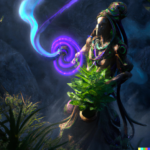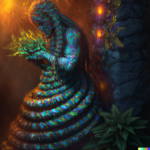Salvia Divinorum: The Mysterious Plant
Have you ever heard of the plant called Salvia Divinorum? It has been used for centuries in traditional medicine and spiritual practices. However, in recent years, it has gained popularity as a recreational drug, raising concerns about its safety and potential for addiction.
In this article, we will delve into the world of Salvia Divinorum, exploring its traditional and modern uses, effects, and potential dangers. We will also provide tips on how to identify this unique plant, including its appearance, smell, taste, and chemical composition.
If you’re curious about Salvia Divinorum or looking for information on how to seek help for addiction, this article has got you covered. Keep reading to discover everything you need to know about this mysterious plant.
What Is Salvia Divinorum?
Salvia Divinorum, also known as Diviner’s Sage, is a psychoactive plant native to the Mazatec region of Mexico. It is recognized for its distinct appearance, including unique leaves, stems, and flowers, and is revered for its potent psychedelic effects.
Salvia Divinorum holds significant cultural and spiritual importance due to its traditional use in shamanic rituals by the Mazatec people. In recent years, it has also gained attention for its potential therapeutic benefits, with ongoing research exploring its potential in treating mood disorders and addiction.
Cultivating Salvia Divinorum requires specific techniques to mimic its natural habitat, such as providing the right amount of moisture and shade. Harvesting is a delicate process that must be done carefully to preserve the plant’s psychoactive compounds.
How Is Salvia Divinorum Used?
Salvia Divinorum is used through various methods such as smoking and brewing, with its legal status and ethnobotanical significance deeply rooted in traditional Mazatec practices in Mexico.
What Are The Traditional Uses Of Salvia Divinorum?
The traditional uses of Salvia Divinorum are deeply intertwined with the cultural practices of the Mazatec people in Mexico, where it holds a revered status for its profound psychedelic effects and ethnobotanical significance.
Salvia Divinorum has been a part of Mazatec rituals for centuries. Local healers or shamans incorporate it into spiritual ceremonies, believing in its ability to facilitate communication with the spiritual world. This plant is also thought to provide insights into one’s life.
Today, scientists and researchers are delving into the ancient wisdom associated with Salvia Divinorum. Their goal is to better understand its potential therapeutic applications and impact on mental health.
What Are The Modern Uses Of Salvia Divinorum?
The modern uses of Salvia Divinorum extend to its pharmacological research, exploration of potential medicinal applications, and the identification of distinct chemotypes and compounds such as Salvinorin A.
Researchers have delved deeper into the pharmacology of Salvia Divinorum, examining its interactions with various receptors in the brain and nervous system. Studies have revealed its potential in managing conditions such as depression, anxiety, and chronic pain, shedding light on its medicinal properties.
The ongoing identification of key compounds like Salvinorin A has provided valuable insights into the plant’s therapeutic potential, paving the way for further exploration of its modern applications in treating neurological and mood disorders.
What Are The Effects Of Salvia Divinorum?
The effects of Salvia Divinorum are characterized by its potent psychedelic and hallucinogenic properties, with considerations for consumption, dosing, and associated health risks.
Salvia Divinorum is known for its ability to induce intense visual and auditory hallucinations, alter perceptions of time and space, and cause profound changes in mood when consumed. However, the method of consumption, whether through smoking, chewing, or vaporizing the leaves, can affect the onset and duration of its effects. It is important to carefully consider the dosage, as the potency of Salvia Divinorum can vary significantly. Users should also be aware of potential adverse reactions, such as paranoia, confusion, and disorientation. Additionally, long-term use may pose risks to mental health, highlighting the importance of cautious and informed use.
What Are The Short-term Effects Of Salvia Divinorum?
The short-term effects of Salvia Divinorum encompass its psychoactive nature, drug classification, and immediate impact post-consumption, influencing the user’s cognitive and perceptual experiences.
This hallucinogenic plant, often dubbed as ‘diviner’s sage,’ induces rapid alterations in sensory perception and thought processes upon ingestion. Users may encounter intense visual distortions, such as vivid colors and patterns, and may experience a distorted sense of time and space.
The effects typically peak quickly and diminish within 5 to 15 minutes, leading to a relatively short-lived, but potent, psychoactive episode. Its classification as a dissociative drug accentuates its ability to induce a disconnection between the user’s consciousness and reality, contributing to its short-term psychoactive impact.
What Are The Long-term Effects Of Salvia Divinorum?
The long-term effects of Salvia Divinorum encompass considerations for addiction potential, tolerance development, and the risks of overdose associated with prolonged and excessive usage.
Those who use Salvia Divinorum may find themselves developing a tolerance to its effects over time, requiring higher doses to achieve the same level of high. This increases the risk of overdose as individuals chase the desired effects.
The potential for addiction to Salvia Divinorum cannot be overlooked, as its psychoactive properties can lead to psychological dependence, impacting various aspects of an individual’s life. These long-term consequences highlight the need for increased awareness and caution surrounding the use of this potent herb.
How To Identify Salvia Divinorum?
Identifying Salvia Divinorum involves recognizing its distinctive appearance, olfactory characteristics, gustatory attributes, and understanding its effects and chemical composition.
This plant typically has large green leaves with a distinct square stem. The leaves can vary in size, ranging from small to medium.
When crushed, the leaves emit a powerful, pungent odor that can be described as earthy or herbal. The taste of Salvia Divinorum has an intense bitterness, often leaving a lingering aftertaste.
The effects of consuming Salvia Divinorum can range from mild psychedelic experiences to potent hallucinations, depending on the dosage. Its primary active compound, Salvinorin A, is a potent κ-opioid receptor agonist, distinguishing it chemically from other plants.
Appearance
The appearance of Salvia Divinorum is characterized by its distinct botanical features, including unique leaves, stems, and flowers that distinguish it from other plant species.
Salvia Divinorum is known for its large, vibrant green leaves with a unique heart-shaped appearance and serrated edges. Its stems are also square-shaped, a rare trait in the plant kingdom.
The plant’s small white flowers add a delicate touch to its overall visual appeal. These botanical characteristics make Salvia Divinorum a captivating and distinct addition to any natural setting, attracting the curiosity of botany enthusiasts and nature lovers alike.
Smell
The smell of Salvia Divinorum is characterized by its distinct aroma, fragrance, and olfactory properties, contributing to its sensory profile and recognition.
Its aroma is often described as earthy, with hints of mint and a touch of spice, creating a unique blend that sets it apart from other plants.
The fragrance of Salvia Divinorum can evoke a calming and soothing sensation, with subtle undertones that captivate the senses. Its olfactory properties carry a natural complexity that entices those who encounter it, offering a captivating experience unlike any other.
The scent profile of Salvia Divinorum lends itself to a distinctive olfactory journey, making it a subject of fascination for enthusiasts of unique aromas and fragrances.
Taste
The taste of Salvia Divinorum presents a unique flavor profile, contributing to its gustatory sensation and distinctive sensory experience upon consumption.
Salvia Divinorum offers a complex mix of herbal and minty notes, creating a refreshing and invigorating palate with a hint of earthy undertones.
The flavor is often described as slightly bitter with a touch of sweetness, leaving a lingering aftertaste that evokes a sense of tranquility. Its gustatory sensation encompasses a balance between pungent and soothing elements, making it an intriguing sensory journey for those who appreciate its distinct taste and flavor attributes.
Effects
Understanding the effects of Salvia Divinorum involves recognizing its psychedelic and hallucinogenic nature, considering different methods of consumption, and understanding appropriate dosing practices.
The psychedelic properties of Salvia Divinorum can induce altered states of consciousness, visual distortions, and profound introspection. Its hallucinogenic effects may lead to vivid sensory experiences and a distortion of reality.
Methods of consumption vary, including smoking dried leaves, using extracts, or consuming the leaves orally. It is important to properly dose Salvia Divinorum to prevent negative experiences and ensure safety, as its potency can vary widely depending on the form and preparation method.
Chemical Composition
The chemical composition of Salvia Divinorum encompasses key compounds such as Salvinorin A, which contribute to its psychoactive nature and classification as a potent hallucinogenic drug.
Salvinorin A, a neoclerodane diterpene, is the most potent naturally occurring hallucinogen. Its unique structure allows it to bind to kappa opioid receptors in the brain, triggering intense psychoactive effects.
This compound is responsible for the vivid hallucinations, altered perception of reality, and profound introspective experiences reported by users. Salvia Divinorum also contains other active compounds like salvinorin B, salvinorin C, and divinorin A, all of which interact with the brain to produce its mind-altering effects.
What Are The Dangers Of Using Salvia Divinorum?
Using Salvia Divinorum presents potential dangers, encompassing physical and mental risks, considerations for addiction, tolerance development, the potential for overdose, and the necessity of safety precautions during consumption.
The physical risks of Salvia Divinorum usage include impaired motor coordination, dizziness, and increased heart rate. The mental risks may involve altered perception, confusion, and disorientation.
Addiction to Salvia Divinorum can develop, leading to an increased tolerance and the potential for withdrawal symptoms upon cessation. Overdose is a concern, as excessive consumption can result in severe disorientation and panic.
It is crucial to emphasize safety precautions such as having a trusted individual present, avoiding use in hazardous environments, and being mindful of dosage and frequency to mitigate these risks.
Physical Dangers
The physical dangers of Salvia Divinorum usage encompass potential health risks, overdose incidents, and the importance of adhering to safety precautions for harm reduction.
Individuals experimenting with Salvia Divinorum may experience adverse health effects such as increased heart rate, dizziness, and loss of coordination.
Overdosing on Salvia Divinorum can lead to disorientation, hallucinations, and impaired judgment, posing serious risks to both physical and mental well-being. It is crucial for users to practice caution and be aware of the potential dangers, including ensuring a safe environment and using a trusted source for the substance to minimize health risks and promote overall safety.
Mental Dangers
The mental dangers of Salvia Divinorum usage pertain to potential addiction, tolerance development, and the psychological impact on the user’s mental well-being.
Salvia Divinorum is a potent and fast-acting hallucinogenic plant that comes with significant addiction risks due to its psychoactive properties. Prolonged use can result in tolerance, meaning higher doses are needed to achieve the desired effects, further increasing the potential for addiction.
The psychological impact of Salvia Divinorum on mental health can be profound, inducing intense hallucinations and altered perceptions. This can lead to feelings of anxiety, paranoia, and disorientation, significantly affecting the user’s overall mental well-being. It is crucial to understand and address the potential risks associated with its usage.
How To Seek Help For Salvia Divinorum Addiction?
Addressing Salvia Divinorum addiction requires seeking appropriate support, accessing recovery resources, and undergoing relevant treatment measures to overcome the challenges associated with addiction.
Support can be obtained through various channels such as counseling, support groups, and addiction treatment programs. It is important to reach out to professionals who can provide personalized treatment plans tailored to individual needs.
Recovery options may include therapy, medication-assisted treatment, and holistic approaches. Establishing a strong support system with family and friends can also contribute significantly to the recovery process. It’s advisable to explore available treatment methods, including inpatient and outpatient programs, to determine the most suitable approach for addressing Salvia Divinorum addiction.
Frequently Asked Questions
What is Salvia Divinorum and how can I identify it?
Salvia Divinorum is a psychoactive plant native to Mexico, known for its hallucinogenic effects. It is typically identified by its distinct appearance and characteristics such as its large, heart-shaped leaves and tall stems with purple flowers.
Are there any other plants that may look similar to Salvia Divinorum?
Yes, there are other plants that may resemble Salvia Divinorum, such as mint or sage. However, these plants do not have the same psychoactive properties as Salvia Divinorum. It’s important to properly identify the plant before consuming it.
How can I confirm that the plant I have is actually Salvia Divinorum?
The safest way to confirm the identity of a plant is by consulting with an expert or using a plant identification guide. Salvia Divinorum has specific characteristics that can be easily recognized by those familiar with the plant.
What are some key features I should look for when trying to identify Salvia Divinorum?
In addition to its large leaves and purple flowers, Salvia Divinorum also has square stems and a distinct odor. The underside of the leaves may also have a whitish or silvery color. These are all important characteristics to look for when trying to identify the plant.
Can I find Salvia Divinorum in the wild, or is it only available for purchase?
Salvia Divinorum is native to Mexico and can be found growing wild in certain regions. However, it is also available for purchase from certain suppliers. If you plan on foraging for Salvia Divinorum, make sure to properly identify the plant and ensure that it is legal in your area.
Are there any safety precautions I should take when identifying Salvia Divinorum?
When identifying Salvia Divinorum, it’s important to wear gloves and protective clothing as the plant can cause skin irritation. It’s also important to be cautious when consuming the plant, as it can have strong psychoactive effects and should only be used in a safe and controlled environment.
John Marston, a seasoned writer since 2009, has penned hundreds of articles on Salvia Divinorum across the web. As a full-time writer at a prominent online salvia retailer, he continues to contribute valuable insights, combining expertise and passion to unravel the diverse facets of Salvia Divinorum. Beyond his writing, John serves as a budtender in the cannabis industry.




